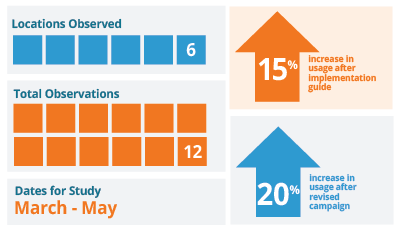CASE STUDY
Ethnographic Research for Patient Registration Pilot

I designed a repeatable, ethnographic research study to document moments of success and points of friction related to the pilot program of Epic’s Welcome kiosks at outpatient registration locations at hospitals in Virginia, Kentucky, and South Carolina.
The Epic Welcome kiosk allows patients to check in and register for their appointments without the need for assistance from hospital staff. There were 2 types of implementations for Welcome: freestanding, touch-screen kiosks or a dedicated computer, monitor, signature pad, and scanner on a desk.
Background
Task/Problem
The pilot program for Welcome had been in place at several locations for 6-18 months. Analytics showed a range of usage at the various sites. Detailed feedback and insight into key factors for the varying degrees of usage was needed in order to optimize for future implementations and determine standards for success.
As the lead user experience designer on the team, I created a one-page worksheet so that observations could be conducted at many locations. Two versions of the worksheet were created showing the preferred workflow for kiosk vs. desktop implementations so observers could note where variances from the design occurred.
One staff member quietly observed the use of Welcome using a print out on a clipboard. Completed sheets were submitted to me for analysis to create a findings report for leadership.
Process
75% of Patients Prefer Face-to-Face Interactions
A key challenge is the strong patient preference of talking with staff before an appointment especially in outpatient surgery locations. There is a balance between time savings, reduction in staff workload, and a patient’s desire to interact with a compassionate caregiver before surgery.
MyChart Usage & Welcome Usage are Related
Patients with an existing MyChart account were 75% more likely to use Welcome and had already completed many of the registration steps before arrival.
Presentation Matters
The appearance and location was a key factor in increased use of Welcome. Kiosks placed immediately inside the registration area (closer to the patient entrance and waiting area than the registration staff desks) were used 80% more frequently than locations with the staff desks closer to the entrance.
Low utilization sites (Welcome usage <30%) included desk implementations will poor signage, excessive cords/cables on the desktop (see photo above), and computer monitors that were frequently in “sleep” mode.
Key Findings
A best practice implementation guide was created to address the physical usage barriers. A 15% increase in usage at the pilot locations was reported 6 months after the guide was issued and the recommended site changes were made.
The marketing department created improved signage and launched a revised campaign to promote the patient benefits of Welcome. Sites with the new signage and campaign had a 20% increase in usage.

